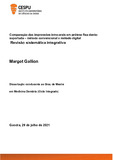| dc.contributor.advisor | FONSECA, JOSÉ PEDRO DE JESUS BARREIROS DA | |
| dc.contributor.author | Gallion, Margot | |
| dc.date.accessioned | 2022-02-10T11:58:57Z | |
| dc.date.available | 2022-02-10T11:58:57Z | |
| dc.date.issued | 2021 | |
| dc.identifier.uri | http://hdl.handle.net/20.500.11816/3877 | |
| dc.description.abstract | Introdução: Impressões dentárias são usadas para obter informações da condição intraoral. Com o aparecimento dos sistemas scanner intra-orais de impressões, a eliminação completa dos modelos físicos obtidos através dos sistemas de impressão convencional tornou-se possível. Assim, a condição intra-oral é registada digitalmente usando um dispositivo de aquisição 3D intra-oral e as informações adquiridas permitem que o computador gere um modelo virtual.
Objetivos: Discutir os protocolos de obtenção de informação intra-oral, comparando o método totalmente digital e o método convencional. E estabelecer o protocolo para cada um dos métodos e evidenciar as vantagens e desvantagens de cada método.
Material e Métodos: Foi realizada uma pesquisa na base de dados PubMed em março de 2021, utilizando a seguinte combinação de termos de pesquisa: (((((cad cam [MeSH Terms]) OR (digitalworkflow)) AND (crowns, dental [MeSH Terms])) OR (bridge, fixed[MeSH Terms])) OR (prosthodontic[MeSH Terms])) AND (digital)
Resultados: Foram incluídos 13 estudos selecionados em função dos critérios de inclusão e de exclusão.
Conclusão: Apesar da insuficiência de dados dos vários estudos, podemos concluir o seguinte: tanto o método digital como o convencional garantem uma confeção clinicamente aceitável de próteses fixas. No que respeita ao tempo de trabalho, as diferenças entre impressões convencionais e digitais não foram significativas. Não foi encontrada qualquer diferença no conforto do paciente e do clínico entre impressões convencionais e digitais porque os estudos se contradizem. | pt_PT |
| dc.description.abstract | Introduction: Dental impressions are used to obtain information of the intraoral condition. With the advent of the intraoral impression scanner systems, the complete elimination of physical models obtained through conventional impression systems are become possible. Thus, the intraoral condition is digitally recorded using an intraoral 3D acquisition device and the required information allows the computer to generate a virtual model.
Objectives: Discuss protocols for obtaining intra-oral information, comparing the fully digital method and the conventional method. And establish the protocol for each of the methods and highlight the advantages and disadvantages of each method.
Materials and Methods: A search was performed in the PubMed database in March 2021, using the following combination of search terms: (((((cad cam [MeSH Terms]) OR (digitalworkflow)) AND (crowns, dental [MeSH Terms])) OR (bridge, fixed [MeSH Terms])) OR (prosthodontic[MeSH Terms])) AND (digital)
Results: 13 studies selected according to the inclusion and exclusion criteria were included.
Conclusions: Despite the lack of data from the various studies, we can conclude the following: both the digital and the conventional methods guarantee a clinically acceptable manufacture of fixed prostheses. With regard to working time, the differences between conventional and digital prints were not significant. No difference in patient and clinician comfort was found between conventional and fingerprint impressions because the studies contradict each other. | pt_PT |
| dc.language.iso | por | pt_PT |
| dc.rights | info:eu-repo/semantics/openAccess | pt_PT |
| dc.subject | CAD-CAM | pt_PT |
| dc.subject | Workflow | pt_PT |
| dc.subject | Digital | pt_PT |
| dc.subject | Crown | pt_PT |
| dc.subject | Bridge | pt_PT |
| dc.subject | Dental prosthesis | pt_PT |
| dc.title | Fluxo digital em Prótese fixa dento-suportada Revisão sistemática integrativa | pt_PT |
| dc.type | info:eu-repo/semantics/masterThesis | pt_PT |
| dc.identifier.tid | 202911845 | pt_PT |
| thesis.degree.name | Mestrado em Medicina Dentária | pt_PT |

